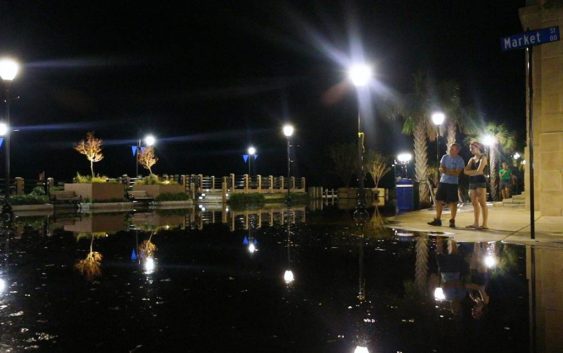- EF-1 tornadoes ripped through Cypress, Waller County areas with winds at more than 100 mph, NWS reports
- Houston-area storm damage updates: Clean up continues after NWS says two EF-1 tornadoes and powerful derecho ripped through SE Texas
- Low risk of damaging winds, hail from Saturday storms
- EF 1 tornadoes ripped through Cypress, Waller County areas at more than 100 mph, NWS reports
- Caddo Mounds State Historic Site to celebrate new visitor center, traditional grass house after 2019 tornado
How utility workers held off a hurricane and kept water running to Wilmington homes

The sun had begun to set that Friday evening in late September as Jim Tayson stopped his truck on U.S. 421 near Fishing Creek, in the northwestern corner of New Hanover County, to survey the situation.
A 48-inch pipe crosses under the highway there from west to east before turning south to convey Cape Fear River water to treatment plants serving more than 100,000 people in New Hanover and Pender counties.
Now, with flood waters from Hurricane Florence rising, coursing over the four-lane highway, the pipeline was in peril. Losing it would deliver a gut punch of water rationing and other emergency measures to residents already pummeled by days of water and winds and the ensuing damage.
“I saw 421 gone and heavy flood water crossing it,” said Tayson, water distribution and construction superintendent at the Cape Fear Public Utility Authority.
“It looked like something out of a whitewater rafting promotional commercial, water roaring and blowing. The guardrails were washing away, and trees were bent over. It was something that you won’t forget.
“You could see the crown of the pipe as it crosses 421 there. Once it dumps onto the east side, the water was swirling in a clockwise fashion. As it swirled back toward the edges of 421 it was just taking all the bank and everything that supports the highway, just washing it out and eroding it away. The outside northbound lane was completely washed out. It was just a big old chunk of asphalt hanging in the air.
“Our raw water line was right there.”
Tayson noted that “a column of water 48 inches in diameter has a lot of force.”
“If you don’t have something around it like all that soil to hold that stuff together, it’s going to break. It’s not a matter of if, but when. If we’d let it go just a few more hours, there probably would have been eight or 10 feet of it that would hanging out in the air.”
No stranger to emergencies
Tayson is no stranger to emergencies. Just two years before, he helped oversee repairs on a raw water main damaged in the aftermath of Hurricane Matthew.
That work had required patching the pipe. This time, he needed another solution, and he had something in mind.
So, late Friday night, a group of CFPUA leaders and staff huddled in the emergency operations center at the Sweeney Water Treatment Plant in Wilmington, where raw river water is treated to supply about 80 percent of the utility’s customers.
“It was maybe 11 o’clock and we were sitting over at Sweeney,” said CFPUA executive director Jim Flechtner.“We said, ‘Do we go to mandatory water conservation now and try to get people to try to start saving water, or do we wait?’
“Tayson said, ‘I’ve got a plan. Let me go see if it works and we’ll know by morning,’ “ Flechtner said.
Tayson explained that he would build a berm to divert the current and protect the pipe. He would organize a circuit of four dump trucks to ferry heavy soil used for roadbeds from a CFPUA construction yard on the south side of Wilmington to the site on U.S. 421 while he manned an excavator to position and tamp down the material.
“At 11 o’clock, we decided to give his plan a chance to work,” Flechtner said. “At that point at night, few people are awake. By going to mandatory water conservation, we wouldn’t have accomplished anything.”
More complications
Complicating the already precarious situation, a fallen tree pierced a pipe in Wilmington, causing water to begin draining from a storage tank crucial to New Hanover Regional Medical Center, so Tayson split his forces to deal with that as well.
That left him six workers to drive trucks and work at the pipe, plus a few to load the heavy dirt at the Wilmington construction yard.
By 6:30 a.m., they had successfully protected the pipe.
“There is nothing more satisfying than to see these guys work,” Tayson said. “Their homes are also damaged by the hurricane. Just like everybody else, they’re worried about their families, but they still find the gumption to come in here and take care of what they need to take care of.
“Most of the people in the county do not realize how close they are to losing this service that’s provided to them, and they don’t realize what we’re out there doing and how close they’re coming to going two, three or four days without water.”
He credited his staff’s dedication to the fact that Wilmington residents didn’t go “two, three or four days without water.”
“Everybody wakes up the next morning and the water is flowing and the toilets are flushing and everything’s good with the world.”
This article first appeared in the Carolina Public Press, an independent non-profit news organization.